अक्सर हम सांभर के कटोरे में इसे तैरते हुए देखते हैं, सहजन (ड्रमस्टिक) को वैज्ञानिक दृष्टि से मोरिंगा ओलेइफेरा लैम के नाम से जाना जाता है। यह मोरिंगेसी वृक्ष परिवार से संबंधित है। यह एक छोटा, तेज़ी से बढ़ने वाला, सदाबहार पेड़ है जो उष्णकटिबंधीय (ट्रॉपिकल) क्षेत्रों में उगता है। यह भारत, बांग्लादेश, अफगानिस्तान और पाकिस्तान के हिमालयी क्षेत्रों में पाया जाता है। सहजन (ड्रमस्टिक) को हॉर्सरैडिश ट्री या ड्रमस्टिक ट्री (अंग्रेजी में), सुभंजना (संस्कृत में), हरिताशाका या अक्षीवा (आयुर्वेद में) और सैन्जना या सगुना (हिंदी में) के रूप में भी जाना जाता है।1
सहजन (ड्रमस्टिक) के प्रत्येक भाग में मानव स्वास्थ्य के लिए आवश्यक गुण होते हैं; इसलिए, यह महत्वपूर्ण पोषण संबंधी जड़ी बूटियों में से एक है। कई वर्षों से सहजन (ड्रमस्टिक) का उपयोग पारंपरिक चिकित्सा दवा के रूप में किया जाता रहा है। आयुर्वेदिक चिकित्सा पद्धति के अनुसार, सहजन (ड्रमस्टिक) की हाई न्यूट्रिशनल वैल्यू, जल धारण करने की क्षमता और शुद्धिकरण क्षमता के कारण विभिन्न बीमारियों के लिए यह उपयोगी और मददगार है।1
सहजन (ड्रमस्टिक) महत्वपूर्ण खनिज और पोषक तत्वों की बड़ी और दुर्लभ किस्म प्रदान करता है। सहजन (ड्रमस्टिक) के कंद, पत्ते, फूल, छाल, जड़ और बीज में भी बायोएक्टिव यौगिक होते हैं।1
| पोषक तत्व | मात्रा/100 ग्राम में |
| ऊर्जा | 37 किलोकैलोरी |
| प्रोटीन | 2.1 ग्राम |
| फ़ैट (वसा) | 0.2 ग्राम |
| कार्बोहाइड्रेट | 8.53 ग्राम |
| फ़ाइबर | 3.2 ग्राम |
| कैल्शियम | 30 मिलीग्राम |
| आयरन | 0.36 मिलीग्राम |
| मैगनीशियम | 45 मिलीग्राम |
| फ़ास्फोरस | 50 मिलीग्राम |
| पोटैशियम | 461 मिलीग्राम |
| सोडियम | 42 मिलीग्राम |
| ज़िंक | 0.45 मिलीग्राम |
| कॉपर | 0.084 मिलीग्राम |
| मैंगनीज | 0.259 मिलीग्राम |
| सेलेनियम | 0.7 म्युग्राम |
| विटामिन सी | 141 मिलीग्राम |
| थायमिन | 0.053 मिलीग्राम |
| राइबोफ्लेविन | 0.074 मिलीग्राम |
| विटामिन बी6 | 0.12 मिलीग्राम |
| फ़ोलेट | 44 म्युग्राम |
| विटामिन ए | 4 म्युग्राम |
टेबल 1:प्रति 100 ग्राम कच्चे सहजन (ड्रमस्टिक) के कंद (फली) में पोषण क मात्रा2
सहजन (ड्रमस्टिक) के प्रमुख घटकों में बायोलॉजिकल गतिविधियां होती हैं जो आयुर्वेद, होम्योपैथी, यूनानी, योग, निसर्ग-चिकित्सा पद्धति और सिद्धा जैसी अनेक औषधीय प्रणालियों में इसके संभावित उपयोग में भूमिका निभा सकती हैं।1 सहजन (ड्रमस्टिक) के संभावित गुण इस प्रकार हैंः
सहजन (ड्रमस्टिक) का उपयोग हाई न्यूट्रिशन वैल्यू के साथ कई प्रकार से किया जा सकता है। इस पौधे के विभिन्न भाग उत्प्रेरक के रूप में कार्य करते हैं जो विशेष रूप से दक्षिण एशिया के स्थानीय चिकित्सा प्रणालियों में विभिन्न रोगों को ठीक करने के लिए नियोजित विभिन्न गतिविधियों को करते हैं।3 सहजन (ड्रमस्टिक) के संभावित उपयोगों में से कुछ इस प्रकार हैं।
सहजन (ड्रमस्टिक) के पत्ते के रस में एंटी-डायबटीज़ गुण दिखाई देता हैं जो हमारे ब्लड ग्लूकोज़ के स्तर को कम करने में मदद करता हैं। एक पशु पर हुए अध्ययन (गुप्ता आर और अन्य 2012) से पता चला कि सहजन (ड्रमस्टिक) के पत्तों का रस डायबटीज़ की वृद्धि को कम करने में मदद कर सकता है और प्रोटीन व इंसुलिन हार्मोन के बनने में वृद्धि करके सीरम ग्लूकोज़ के स्तर में कमी भी ला सकता है।1
पशु पर हुए एक अन्य अध्ययन (नोंग एम और अन्य 2007) से पता चला कि सहजन (ड्रमस्टिक) के पत्तों का रस रक्त में ग्लूकोज़, मूत्र में शर्करा, प्रोटीन, हीमोग्लोबिन और कुल प्रोटीन के स्तर को नियंत्रित करने में मदद कर सकता है।4 हालांकि, उपरोक्त दावों को सत्यापित करने के लिए और ज़्यादा अध्ययन करने होंगे। क्योंकि डायबिटीज़ एक गंभीर बीमारी है और इसका निदान व इलाज डॉक्टर द्वारा ही किया जाना चाहिए तो कृपया डॉक्टर से परामर्श करें।
पशुओं पर हुए विभिन्न अध्ययन (बी. एस राठी और अन्य 2006, वी.आई. हुक्केरी और अन्य 2006) से पता चलता है कि सहजन (ड्रमस्टिक) के सूखे पत्तों से निकला गया रस पशुओं के मॉडल में ग्रैन्युलोमा (डेड स्पेस), कटे और चीरे घाव भरने की क्रिया प्रदर्शित कर सकता है। यह घाव की जगह को भी काफ़ी हद तक कम कर सकता है, घाव के भरने में मदद कर सकता है, और त्वचा की पपड़ी की टूटन को मज़बूत कर सकता है।4 हालांकि, घाव भरने के लिए सहजन (ड्रमस्टिक) के संभावित उपयोगों को साबित करने के लिए मनुष्यों पर अभी और ज़्यादा अध्ययन करने की आवश्यकता है।
सहजन (ड्रमस्टिक) की छाल, पत्तियां, बीज, फूल और जड़ों में ड्यूरेटिक गतिविधि होती है जो कि किडनी डिस्फंक्शन (दुष्क्रिया) वाले रोगियों में पेशाब के बनने में सहायक होती है। यह किडनी में ऑक्सालेट नमक (पथरी बनाने वाली इकाइयां) के जमाव को कम करने में भी मदद कर सकता है। पशु पर हुए एक अध्ययन (आर. वी. कराडी और अन्य 2008) में पाया गया कि सहजन (ड्रमस्टिक) की जड़ का रस किडनी में नमक और मूत्र के उत्सर्जन को कम करता है। इसके अलावा, ये रस बड़े हुए सीरम यूरिक एसिड और क्रिएटिनिन के स्तर को भी कम करते हैं।4 यह जानकारी अपर्याप्त है क्योंकि ये अध्ययन अभी सिर्फ पशुओ पर किए गए है। हालांकि, इस दावे का समर्थन करने के लिए मनुष्यों पर इसके और अधिक अध्ययन की आवश्यकता है। किडनी की बीमारी गंभीर होती हैं और उनका निदान और इलाज डॉक्टर द्वारा ही किया जाना चाहिए, इसलिए कृपया डॉक्टर से परामर्श करें। हम सलाह देते हैं कि आप डॉक्टर से सलाह लेने से पहले खुद से इलाज करने के लिए सहजन (ड्रमस्टिक) का उपयोग न करें।
सहजन (ड्रमस्टिक) के पत्ते और बीज संभावित एंटी-ट्यूमर गतिविधियों को दर्शाते है। इसमें कुछ यौगिक होते हैं जो अवरोधक के रूप में कार्य कर सकते हैं और ट्यूमर बढ़ाने वाले अणुओं की गतिविधि को बाधित कर सकते हैं। मानव कैंसर की कोशिकाओं पर इन-विट्रो अध्ययनों से पता चला कि सहजन (ड्रमस्टिक) के पत्ते के रस की अधिकतम खुराक कैंसर कोशिकाओं के संभावित विषाक्त प्रभाव कैंसर कोशिकाओं की संख्या को कम करने में अपना योगदान देती है।4 हालांकि, कैंसर के लिए सहजन (ड्रमस्टिक) के संभावित उपयोग को साबित करने के लिए अभी बहुत ज़्यादा व्यापक शोधों की आवश्यकता है। इसके अलावा, कैंसर एक गंभीर बीमारी है और इसका निदान और इलाज डॉक्टर द्वारा ही किया जाना चाहिए।
यद्यपि ऐसे और भी अध्ययन हैं जो विभिन्न स्थितियों में सहजन (ड्रमस्टिक) के संभावित उपयोगों को दर्शाते हैं, लेकिन वे अपर्याप्त हैं, और हमें मानव स्वास्थ्य पर सहजन (ड्रमस्टिक) के लाभों की वास्तविक सीमा स्थापित करने के लिए आगे और ज़्यादा अध्ययन करने की ज़रूरत है।
Sehjan(Drumstick) ka upyog kaise karein?
ड्रमस्टिक का प्रयोग निम्नलिखित तरीकों से किया जा सकता हैः
नियमित रूप से सहजन (ड्रमस्टिक) का सेवन करने से पहले आपको हमेशा अपने आयुर्वेदिक चिकित्सक से परामर्श लेना चाहिए। वे आपकी स्वास्थ्य स्थिति के अनुसार सही रूप और खुराक निर्धारित करने के लिए सबसे अच्छे व्यक्ति होंगे।
किसी भी हर्बल सप्लीमेंट को लेने से पहले आपको किसी योग्य डॉक्टर से परामर्श करना चाहिए। किसी योग्य चिकित्सक से परामर्श किए बिना आधुनिक चिकित्सा के चल रहे उपचार को आयुर्वेदिक/जड़ी-बूटियों की तैयार दवा से न तो बदलें या न ही रोकें।
पिछले कुछ वर्षों में, सहजन (ड्रमस्टिक) की प्राकृतिक उत्पत्ति और कुछ दुष्प्रभावों के कारण इस पर काफ़ी शोध किये गए है। यह एंटी-एलर्जिक एजेंट होता है और आयुर्वेदिक चिकित्सक की देखरेख में जड़ी-बूटियों के उपचार के रूप में इस्तेमाल किया जा सकता है।4,5 हालांकि, कुछ लोगों को सहजन (ड्रमस्टिक) के बीज की फलियों से एलर्जी हो सकती है। इसके सबसे सामान्य दुष्प्रभाव निम्न हैंः
आम तौर पर सहजन (ड्रमस्टिक) को सुरक्षित माना जाता है अगर इसे कम मात्रा में खाया जाए। हालांकि, दिक्कतों से बचने के लिए सामान्य सावधानी बरतनी होगी।
कृपया अपनी मर्ज़ी से दवाई न लें, कृपया चल रहे किसी भी इलाज को अपने आप न घटाएं-बढ़ाएं, न बदलें या न रोकें। कृपया स्वास्थ्य संबंधी समस्याओं के बारे में अपने डॉक्टर से परामर्श करें।
सहजन (ड्रमस्टिक) में अनेकों बायोएक्टिव यौगिक होते हैं, जो कि कई ड्रग-मेटाबोलाइजिंग एंजाइमों के साथ क्रियाएँ करते हैं जिसके परिणामस्वरूप दवा के अवशोषण, वितरण, उपापचय और शरीर से निरसन में परिवर्तन होता है और जो संभवतः विषाक्तता और उपचार की विफलता का कारण बनता है। सहजन (ड्रमस्टिक) के पत्तों का रस ऐसे एंजाइमों में से एक को रोकता है, जो दवाओं के विषाक्तीकरण के लिए ज़िम्मेदार है।6
सहजन (ड्रमस्टिक) का सेवन करने से पहले डॉक्टर से सलाह लें और सुनिश्चित करें कि यह आपके लिए सुरक्षित है।
सहजन (ड्रमस्टिक) में विटामिन A, C, B1, B2, B6 और B9 जैसे विटामिन होते हैं जो विभिन्न स्वास्थ्य स्थितियों के लिए फ़ायदेमंद हो सकते हैं।2 हालांकि, लोगों को डॉक्टर से परामर्श करने से पहले खुद से चिकित्सा के लिए सहजन (ड्रमस्टिक) का उपयोग नहीं करना चाहिए।
गर्भावस्था के दौरान सहजन (ड्रमस्टिक) के संभावित उपयोग के बारे में अपर्याप्त और अनिश्चित डेटा उपलब्ध है। कृपया इसे खाने से पहले अपनी गाइनकॉलजिस्ट (स्त्री रोग विशेषज्ञ) से परामर्श करें और इसे खाने से पहले पता करें कि यह सुरक्षित है या नहीं।
हां। सहजन (ड्रमस्टिक) के पत्तों का रस थायरॉयड हार्मोन के लिए सहायक हैं जो आगे हाइपरथायरायडिज्म (अतिरिक्त थायरॉयड हार्मोन) में और मदद कर सकता हैं।3
सहजन (ड्रमस्टिक) के अन्य सामान्य नाम मुरिन्ना या सिगरू (मलयालम में), ला केन (चाइनीज़ में), सुरगावो (गुजराती में), सैंजना या सोंजना (पंजाबी में), मॉरिगकाई (तमिल में), रावांग (अरबी में) और मुलागा या मुनागा (तेलुगु में) हैं।4
सहजन (ड्रमस्टिक) के कारण होने वाली एलर्जी की प्रतिक्रियाओं का पता लगाने के लिए स्किन प्रिक (सुईं) टेस्ट एक संभावित नैदानिक टूल है।
सहजन की तासीर उष्ण और उर्जावान करने वाली होती है। यह शरीर को ऊर्जा प्रदान करता है और पाचन को सुधारता है।
सहजन आमतौर पर अम्लता का कारण नहीं बनता और इसे पाचन के लिए अच्छा माना जाता है। हालांकि, हर व्यक्ति का शरीर अलग होता है, इसलिए कुछ लोगों को व्यक्तिगत प्रतिक्रिया के रूप में अम्लता महसूस हो सकती है। यदि सहजन खाने के बाद अम्लता होती है, तो इसकी मात्रा कम करें या किसी चिकित्सा विशेषज्ञ से परामर्श लें।
सहजन आमतौर पर रक्तचाप को बढ़ाता नहीं है, बल्कि इसे नियंत्रित करने में मदद कर सकता है। इसमें पोटैशियम और अन्य पोषक तत्व होते हैं जो रक्तचाप को संतुलित रखने में सहायक होते हैं। लेकिन अगर आपको विशेष स्वास्थ्य स्थितियाँ हैं, तो इसे आहार में शामिल करने से पहले डॉक्टर से परामर्श करें।
सहजन की फलियों को कच्चा नहीं खाना चाहिए, क्योंकि वे कठोर और पचाने में कठिन हो सकती हैं। इन्हें पकाकर या उबालकर खाना बेहतर होता है ताकि इनके पोषक तत्व आसानी से अवशोषित हो सकें और पाचन में सहायक हों।
किडनी के मरीज सहजन खा सकते हैं, लेकिन इसे आहार में शामिल करने से पहले डॉक्टर से परामर्श करना जरूरी है। सहजन में पोटैशियम की मात्रा अधिक होती है, जो किडनी की समस्याओं वाले लोगों के लिए हानिकारक हो सकता है।
कुत्तों को सहजन की सब्जी नहीं खिलानी चाहिए। इसमें कुछ ऐसे तत्व हो सकते हैं जो कुत्तों के लिए हानिकारक हो सकते हैं। कुत्तों के लिए उचित आहार के बारे में हमेशा पशु चिकित्सक से परामर्श लें।
हाँ, सहजन मधुमेह के लिए फायदेमंद हो सकता है। इसमें मौजूद पोषक तत्व और एंटीऑक्सीडेंट्स रक्त शर्करा के स्तर को नियंत्रित करने में मदद कर सकते हैं। फिर भी, इसे आहार में शामिल करने से पहले डॉक्टर से परामर्श करना उचित है।
हाँ, सहजन और मोरिंगा एक ही हैं। मोरिंगा का वैज्ञानिक नाम मोरिंगा ओलिफेरा है और इसे आमतौर पर सहजन के नाम से जाना जाता है।
Disclaimer: The information provided here is for educational/awareness purposes only and is not intended to be a substitute for medical treatment by a healthcare professional and should not be relied upon to diagnose or treat any medical condition. The reader should consult a registered medical practitioner to determine the appropriateness of the information and before consuming any medication. PharmEasy does not provide any guarantee or warranty (express or implied) regarding the accuracy, adequacy, completeness, legality, reliability or usefulness of the information; and disclaims any liability arising thereof.
Links and product recommendations in the information provided here are advertisements of third-party products available on the website. PharmEasy does not make any representation on the accuracy or suitability of such products/services. Advertisements do not influence the editorial decisions or content. The information in this blog is subject to change without notice. The authors and administrators reserve the right to modify, add, or remove content without notification. It is your responsibility to review this disclaimer regularly for any changes.
Disclaimer: The information provided here is for educational/awareness purposes only and is not intended to be a substitute for medical treatment by a healthcare professional and should not be relied upon to diagnose or treat any medical condition. The reader should consult a registered medical practitioner to determine the appropriateness of the information and before consuming any medication. PharmEasy does not provide any guarantee or warranty (express or implied) regarding the accuracy, adequacy, completeness, legality, reliability or usefulness of the information; and disclaims any liability arising thereof.
Links and product recommendations in the information provided here are advertisements of third-party products available on the website. PharmEasy does not make any representation on the accuracy or suitability of such products/services. Advertisements do not influence the editorial decisions or content. The information in this blog is subject to change without notice. The authors and administrators reserve the right to modify, add, or remove content without notification. It is your responsibility to review this disclaimer regularly for any changes.
Recently, there has been recurring news in the media about the increasing cases of the H3N2 virus. It appears to be affecting a large portion of the population nationwide. The typical symptoms of H3N2 include prolonged cough, sneezing, weakness, fever, sore throat, and ear pain.
H3N2 is a viral infection that is usually self-limiting but requires management under medical supervision. Some cases may worsen and require hospitalisation. Therefore, experts emphasize the importance of careful monitoring and preventive measures.
Is the H3N2 virus dangerous? How can you detect this H3N2 influenza virus and stay protected? We have all the information you need.
So, let’s get started!
Prevention and treatment are closely linked to the early detection of disease, which is why it’s essential to familiarize yourself with the symptoms of H3N2 influenza.
Some common symptoms seen in H3N2 seasonal infection are below:
In H3N2 influenza viral infection, coughing can be quite severe, lasting up to two weeks. Although most people recover from the fever within a week, H3N2 influenza can cause serious illness and necessitate hospitalization in some individuals, and can be particularly dangerous for certain high-risk patients. That is why it is crucial to monitor the patient and seek expert help if the symptoms don’t recede or seem to worsen.
Hospitalisation may be needed for high-risk groups. So this is something to keep in mind if someone in your household with comorbidities such as asthma, COPD, obesity, heart or lung disorders is diagnosed with this infection.
Certain high-risk groups are more susceptible to vulnerabilities than others. If you or your loved ones are in such groups, exercising caution is suggested:
The annual influenza vaccine also provides protection against H3N2 influenza, as well as other types of influenza A, such as H1N1, and certain strains of influenza B.
One annual shot can reduce the risk of severe infection and hospitalisation in everyone.
Discuss the annual flu vaccine with your doctor for yourself and your family.
The majority of H3N2 influenza cases are diagnosed clinically; however, during periods of low activity, infections with other respiratory viruses, such as COVID-19, respiratory syncytial virus, rhinovirus, and adenovirus, can also present as influenza-like illnesses, making clinically differentiating H3N2 influenza from other environmental pathogens a challenging task.
To determine the nature of the pathogen, a respiratory sample, along with a laboratory diagnostic test, will be necessary.
Tests that may be advised by your doctor-
Also Read: How Long Does a Flu Last and Ways to Manage Them
Seasonal influenza, such as the H3N2 virus, can be challenging to contain, especially in densely populated regions, unless everyone maintains good respiratory hygiene at all times. To minimize your chances of infection, get vaccinated every year to maintain optimal vaccine efficacy. Spreading awareness of the do’s and don’ts among your loved ones, friends, colleagues, and educational institutions will also help protect others from contracting the infection.
Also Read: Influenza A: What is It, Causes, Symptoms, Treatment & Prevention
Disclaimer: The information provided here is for educational/awareness purposes only and is not intended to be a substitute for medical treatment by a healthcare professional and should not be relied upon to diagnose or treat any medical condition. The reader should consult a registered medical practitioner to determine the appropriateness of the information and before consuming any medication. PharmEasy does not provide any guarantee or warranty (express or implied) regarding the accuracy, adequacy, completeness, legality, reliability or usefulness of the information; and disclaims any liability arising thereof.
Links and product recommendations in the information provided here are advertisements of third-party products available on the website. PharmEasy does not make any representation on the accuracy or suitability of such products/services. Advertisements do not influence the editorial decisions or content. The information in this blog is subject to change without notice. The authors and administrators reserve the right to modify, add, or remove content without notification. It is your responsibility to review this disclaimer regularly for any changes.
Ayurveda has enlisted the importance of various Arishtas (herbal decoctions) and Asavas (herbal infusion) which are self-fermented polyherbal preparations. These may be well known for the management of digestive and metabolic disorders. One such preparation is Pancharishta. Pancharishta is a traditional Ayurvedic polyherbal syrup (different herbs) popularly used for centuries in India. It is a combination of Asavas and Arishtas. This polyherbal Pancharishta is made by combining and fermenting thirty-five different Ayurvedic herbal plants. Pancharishta may be considered a unique medicinal wine. It is a self-formed alcoholic preparation that may contain approximately 12% of alcohol. Pancharishta syrup formulations may have been used widely from the ancient period without knowing any side effects1,3. Let us discuss the health benefits of Pancharishta, its nutritional ingredients, potential uses and more.
Below listed are the ingredients of Pancharishta (Value in %):
Pancharishta may also contain other ingredients such as ajwain, clove, sugar cane, cumin, coriander, aloe vera and Kunwa (Yeast). It may also contain bioactive phytochemicals like phenol, tannin, saponins, glycosides, carbohydrates, flavonoids, gingerol, piperine and alcohol1,3.
Pancharishta syrup may include the following biological properties:
As Pancharishta is a polyherbal solution prepared by fermentation, it might have detoxification effects on the body due to the presence of various flavonoid and phenolic compounds.
Dr. Siddharth Gupta, B.A.M.S, M.D (Ayu)
The following may be the potential uses of Pancharishta syrup:

Hyperacidity is caused due to rise in digestive juices creating an acidic environment in the stomach. It may cause heartburn, indigestion, gas etc. An animal study3 by Adhikari et al. 2018 found that Pancharishta contains herbs that may reduce the secretion of stomach acid and increase the pH in the stomach. Thus, it may help in lowering stomach acids and relieving hyperacidity. However, human research is needed to conclude the use of Pancharishta for hyperacidity. If you experience frequent acidity, consult a specialist doctor. Avoid self medication.

Pancharishta syrup is a fermented decoction. It comprises several ‘good bacteria’ which may enhance the digestion process. It may be used as a digestive tonic which may help release digestive enzymes allowing proper digestion of food. It also contains ingredients like Tvak, Lavanga, Tvakpatra and Dhanyaka these are carminative herbs. These may contribute to carminative activity releasing flatulence, bloating, gas and indigestion. Adhikari et al. 2018 suggest Pancharishta may help with digestion in animals. Further human studies are expected to support the benefits of Pancharishta for digestion1,3. If you have digestion problems take the doctor’s advice. Do not self-medicate.
Pancharishta is a polyherbal medicine made by ancient Ayurvedic methods known as Arishta and Asava. It is commonly used as a digestive and cardioprotective tonic.
Dr. Rajeev Singh, BAMS

People might experience stomach pain and stomach cramping due to various digestion issues. An animal study3 by Adhikari et al. 2018 reported that Pancharishta may have anti-spasmodic activity. It may help contractions of stomach muscles. It may assist in relaxation and stop cramps in the stomach and intestine. This may help reduce stomach upsets and pain. Further studies are needed to completely understand the effects of Pancharishta on stomach cramps. Consult a qualified physician and take Pancharishta only if recommended.
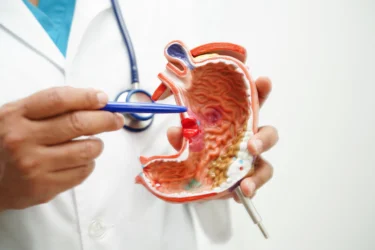
Gastric ulcers happen due to an imbalance in stomach acids and bacterial infection by Helicobacter pylori. A study3 by Adhikari et al. 2018 observed that gastric ulcers may be reduced with the polyherbal formulation of Pancharishta. It may have the action of safeguarding the stomach mucosal lining and maintaining its structure. Hence, Pancharishta may help preserve the cell lining of the stomach and defend against gastric ulcers. However, this is an animal study, more human studies are required to find the true Pancharishta uses for ulcers. Take medical help if you have gastric ulcers. Self-medication is not recommended.

Gastroparesis is a condition that may affect the regular movement of the muscles in the stomach. This might hamper the stomach emptying. An animal study3 by Adhikari et al., 2018 discovered that Pancharishta ingredients may help empty the stomach. This property has been confirmed in animals however, human studies are awaited to support the true use of Pancharishta for stomach emptying. Consult a doctor if you are experiencing stomach issues.

Though studies show the potential uses of Pancharishta in various conditions, these are insufficient and there is a necessity for further studies to develop the scope of the benefits of Pancharishta on human health.
You should consult a qualified doctor before having Pancharishta in large quantities. Do not discontinue or replace an ongoing modern medical treatment with an ayurvedic/herbal preparation of Pancharishta without consulting an ayurvedic physician. They will guide you with its form and dosage per your health condition.
However, more human research is needed to study the side effects of Pancharishta in humans. You must always consult your doctors and get the proper treatment if you come across side effects.
Also Read: Kumaryasava: Uses, Benefits, Side Effects & More!
Pancharishta in the prescribed dose might be safe. However, having it in larger amounts may produce harmful effects. Therefore, a few precautions are essential:
Also Read: Gulkand(Rose Petal Jam): Uses, Benefits, Side Effects By Dr. Smita Barode
Furthermore, clinical studies are required to suggest the herb-drug interaction between Pancharishta and other medicines. We direct that you consult with a doctor before taking Pancharishta preparation and only take it in the given dosage.
Also Read: Guduchi (Giloy): Uses, Benefits, Side Effects and More!
Pancharishta is an Ayurvedic decoction formulation of thirty-five different Ayurvedic herbs. It is a combination of Asava and Arishta. Pancharishta syrup is an alcoholic preparation that may contain 12% of self-generated alcohol. It has been widely used for all stomach-related disorders1,3.
Pancharishta properties may include carminative, laxative, antioxidant, anti-ulcer, digestive, anti-inflammatory and anti-spasmodic. It may help enhance immunity, reduce stomach acidity and help maintain liver health1,3. If you have any such issues consult with your doctors and avoid self-medication.
Pancharishta may contain thirty-five different plant ingredients. The major ingredient of Pancharishta may be a flower called Dhataki (Woodfordia fruticosa)1,2.
Overdosing on Pancharishta should be avoided. It contains a moderate amount of alcohol1. Therefore, excess consumption of Pancharishta might cause symptoms such as vomiting, mental confusion, dizziness, etc. It is best to avoid overdosing and if any complication appears immediately, seek medical help.
No studies have reported the safe use of Pancharishta during pregnancy. Pregnant women should always consult their doctors before using any Ayurvedic preparations such as Pancharishta. They will advise you on the best form and dosage. Do not self-medicate.
Disclaimer: The information provided here is for educational/awareness purposes only and is not intended to be a substitute for medical treatment by a healthcare professional and should not be relied upon to diagnose or treat any medical condition. The reader should consult a registered medical practitioner to determine the appropriateness of the information and before consuming any medication. PharmEasy does not provide any guarantee or warranty (express or implied) regarding the accuracy, adequacy, completeness, legality, reliability or usefulness of the information; and disclaims any liability arising thereof.
Links and product recommendations in the information provided here are advertisements of third-party products available on the website. PharmEasy does not make any representation on the accuracy or suitability of such products/services. Advertisements do not influence the editorial decisions or content. The information in this blog is subject to change without notice. The authors and administrators reserve the right to modify, add, or remove content without notification. It is your responsibility to review this disclaimer regularly for any changes.
Ayurvedic formulations may have emerged as a traditional alternative for a variety of health problems. Chandanasava is one such Ayurvedic formulation that may be considered a traditional medicine. Chandanasava is an Ayurvedic polyherbal formulation prepared using one or more medicinal herbs. The name Chandanasava is derived from one of the main ingredients, Chandan, known as sandalwood in English. Asava in Chandanasava refers to a fermented infusion that is produced by microbes. Chandanasava has a moderate alcohol content and is made with herbal juices from 24 different herbs. Chandanasava can be fermented with sugar, honey, or jaggery. For Chandanasava preparation, an equal amount of herb powder is mixed with water, as well as jaggery and sugar, and the mixture is boiled and chilled. This is then poured into large vessels and left to ferment for several days. It may belong to the alcohol-based category of drugs. Chandanasava could have been used as a valuable medicine to enhance health1,3. Let us discuss the health benefits of Chandanasava, its nutritional value, potential uses, and more.
Below listed are the Chandanasava ingredients:
Furthermore, phytochemical compounds like glucosides, alkaloids, phytosterols, stilbenes, terpenoids, phenols, flavonoids, glycosides, tannins, saponins and various alcohols and non‑volatile compounds may also be present in it1,2.
The benefits of Chandanasava may be due to the following properties:
Chandanasava may be ideal for enhancing human health2. The following may be the potential uses of Chandanasava:

Women in their forties and fifties may experience physiological changes that cause mild to severe symptoms such as hot flashes, body heat, night sweats, and a burning sensation. Certain phytochemicals in Chandanasava may have cooling properties. Regularly consuming Chandanasava (15-30 ml) with water may produce cooling effects within the body. These properties of Chandanasava may aid in the relief of symptoms such as hot flashes, body heat, night sweats, and a burning sensation5. More human research is required to suggest Chandanasava’s true use for body heat. Consult your doctor if you experience excessive body heat. Do not attempt to self-medicate.
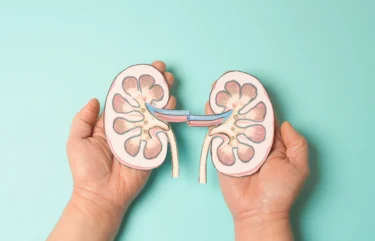
A study4 by Vinothkanna et. al. in 2022 showed Chandanasava may be used against chronic kidney diseases (a long-term kidney failure). It may contain compounds such as piperine and melatonin which may have the potential to stop the bacterial layer (biofilm) formation of infectious diseases involved in kidney diseases. More clinical research is required to form the true scope of Chandanasava against chronic kidney diseases. If you have kidney dysfunction, seek medical attention.
Chandanasava is a polyherbal Ayurvedic formulation. This formulation consists of many nutrients. Research suggests that there are some ten bioactive compounds. These bioactive compounds might be beneficial for managing various systemic diseases like chronic kidney diseases, cardiovascular diseases, etc4.
Dr. Siddharth Gupta, B.A.M.S, M.D (Ayu)

The most common clinical condition among people may be urinary tract infection. Burning sensations and dysuria are possible side effects (difficulty in urination). Chandanasava may be used as a urinary antiseptic. It may have a diuretic effect that may increase urine production and help clear out the urine passage, providing relief from urinary tract infections. Goel and Singh (1991) discovered that the ingredients in Chandanasava may have antimicrobial and antiseptic activity in a clinical trial. This activity may aid in the relief of symptoms such as burning and dysuria6. More human trials are required to establish the efficacy of Chandanasava for UTI. However, if you have a UTI, please take proper medication and do not self-medicate.

Dixit et al. (2012)3 discovered that Chandanasava has antiulcer activity in animals. A stomach juice imbalance can cause a peptic ulcer. Chandanasava may be used as a therapeutic agent to improve stomach conditions. It contains flavonoids, tannins, and terpenoids, all of which have antiulcer properties. As a result, Chandanasava may be beneficial in the healing of peptic ulcers in patients. However, more research is needed to determine Chandanasava’s antiulcer activity. Consult a doctor if you have ulcers.

Though studies show the potential uses of Chandanasava in various conditions, these are insufficient and there is a necessity for further studies to develop the scope of the benefits of Chandanasava on human health.
You should consult a qualified doctor before having Chandanasava in large quantities. Do not discontinue or replace an ongoing modern medical treatment with an Ayurvedic/herbal preparation of Chandanasava without consulting an Ayurvedic physician. They will guide you with its form and dosage per your health condition.
However, more human research is needed to study the adverse effects of Chandanasava on humans. You must consult your doctors to get the proper treatment if you encounter side effects.
Chandanasava is formulated using self-fermentation methods known as Arishtas and Asavas. Studies show that Chandanasava might have antibacterial and anthelmintic activities and might be useful against bacterial and parasitic infections7.
Dr. Rajeev Singh, BAMS
Chandanasava in small and prescribed dosages might be safe. However, having it in larger amounts may harm the body. Therefore, a few precautions are essential:
Chandanasava is a polyherbal Ayurvedic preparation. Its ingredients may or may not interact with other drugs. Further clinical studies are needed to suggest the herb-drug interaction between Chandanasava and other medicines. We advise that you consult with a doctor before taking Chandanasava and only take it in the prescribed dosage.
Also Read: Vasaka (Malabar Nut): Uses, Benefits and Side Effects by Dr. Rajeev Singh
Chandanasava is a polyherbal Ayurvedic formulation. Chandanasava is a fermented formulation made from 24 herbal ingredients. Chandanasava preparation is done using an equal amount of herbs powder in water, jaggery and sugar and boiled and cooled. Then this is poured into big vessels and allowed to ferment for days1.
The Chandanasava ingredients may include Chandan, Raktachandana, Hribera, Priyangu, Musta, Kashmari, Lodhra, Patola, Madhuka, Indivara, Parpata, Manjistha, Ashwattha, Patha, Vata, Priyangu, Bhunimba, Kanchanara, Shati, Rasna, Mocharasa Amra, Dhataki, Guda, Mridvika, water and sugar1.
Chandanasava may have properties such as diuretic, antioxidant, antimicrobial, appetizer, antiseptic, anti-inflammatory, analgesic and anti-ulcer activity1,6. More studies are needed to confirm the true properties of Chandanasava in humans.
Chandanasava may be taken with water5. However, consult with doctors, they will guide you with its better form and dosage according to your health condition.
In a clinical trial6 by Goel and Singh, 1991 found that the ingredients of Chandanasava may have antiseptic activity and antimicrobial activity. It may provide relief against urinary tract infections. This activity may help overcome symptoms like burning sensation and dysuria (burning urination). More human studies are necessary to state the uses of Chandanasava for UTI. However, if you suspect UTI, take proper medicine and do not self-medicate.
1. Vinothkanna A, Sekar S. Influence of intrinsic microbes on phytochemical changes and antioxidant activity of the Ayurvedic fermented medicines: Balarishta and Chandanasava. Pharmaco Study. 2018; 39:169–81. Available from: https://pubmed.ncbi.nlm.nih.gov/31000995/
2. Vinothkanna A, Karthikeyan B, Vijayan R, Sekar S. Assessment of anti-arthritic potential of traditionally fermented ayurvedic polyherbal product chandanasava by molecular modelling, docking and dynamics approaches. Intern J of Comput Biol and Drug Design. 2018;11(4):346–68. Available from: https://www.researchgate.net/publication/328949445_Assessment_of_anti-arthritic_potential_of_traditionally_fermented_ayurvedic_polyherbal_product_chandanasava_by_molecular_modelling_docking_and_dynamics_approaches
3. Dixit P, Sharma P, Jain DK, Jharia V. Systematic Evaluation of Antiulcer Activity of Herbal Formulation ‘Chandanasava’ in Rats. Asian Paci J of Trop Dis. 2012;2(SUPPL.1):192–6. Available from: https://www.researchgate.net/publication/257746795_Systematic_Evaluation_of_Antiulcer_Activity_of_Herbal_Formulation_’Chandanasava’_in_Rats
4. Vinothkanna A, Prathiviraj R, Sivakumar R, Ma Y, Sekar S. GC–MS and Network Pharmacology Analysis of the Ayurvedic Fermented Medicine, Chandanasava, Against Chronic Kidney and Cardiovascular Diseases. Appl Biochem and Biotech. 2022;1–26. Available from: https://link.springer.com/article/10.1007/s12010-022-04242-7
5. Choudhary P, Smitha MV. The Prevalence of Menopausal Symptoms and its Association with Marital Relationship in Perimenopausal Women of Eastern India. J Midlife Health. 2025 Jul-Sep;16(3):285-294. doi: 10.4103/jmh.jmh_82_25. Epub 2025 Sep 5. PMID: 40951856; PMCID: PMC12431706. Available from: https://pmc.ncbi.nlm.nih.gov/articles/PMC12431706/
6. Goel K, Singh R. Clinical Trial of Candanasava, In the Treatment of Urinary Tract Infection. Vol. Anci Sci of Life.1991;X(4):248–52. Available from: https://pmc.ncbi.nlm.nih.gov/articles/PMC3331297/
7. Kumar SV, Sandeep M, Kamal D, et al. Antibacterial and anthelmintic activity of selected fermented Ayurvedic herbal formulations. Drug Invention Today. 2010 Jul;2(7):347-348. Available from: https://web.p.ebscohost.com/
Disclaimer: The information provided here is for educational/awareness purposes only and is not intended to be a substitute for medical treatment by a healthcare professional and should not be relied upon to diagnose or treat any medical condition. The reader should consult a registered medical practitioner to determine the appropriateness of the information before consuming any medication. PharmEasy does not provide any guarantee or warranty (express or implied) regarding the accuracy, adequacy, completeness, legality, reliability, or usefulness of the information; and disclaims any liability arising thereof.
Links and product recommendations in the information provided here are advertisements of third-party products available on the website. PharmEasy does not make any representation of the accuracy or suitability of such products/services. Advertisements do not influence the editorial decisions or content. The information in this blog is subject to change without notice. The authors and administrators reserve the right to modify, add, or remove content without notification. It is your responsibility to review this disclaimer regularly for any changes.
Jackfruit is the largest tree fruit that gained popularity due to its sweet, fleshy and energy-rich pulp. The exterior of jackfruit is hard green or yellow initially and turns to yellowish brown after ripening. The inner edible flesh of the jackfruit consists of nutritious pulp coated around the seed, formed by the fusion of flowers. Jackfruit is a non-seasonal fruit that grows on evergreen trees in tropical areas. The biological name of the jackfruit tree is Artocarpus heterophyllus Lam, belonging to the family Moraceae. It is cultivated in Bangladesh, Sri Lanka, Malaysia and various parts of Southeast Asia, Africa and America. Jackfruit grows abundantly in India and is native to the Western Ghats of India1,2.
Apart from the flesh, jackfruit seeds are also edible and are used in cooked dishes. The jackfruit seeds with a thin brown seed coat, known as spermoderm, are enclosed in a white layer. The brown spermoderm consists of white cotyledon rich in protein and starch. Jackfruit seed has a lot of potential benefits, especially in the cosmetics, paper, pharmaceutical and bio-nanotechnology industries2.
Did you know?
The nutrient value of jackfruit seed is as under:
The potential health benefits of jackfruit seed are:
Magnesium is a mineral crucial for body functioning and keeps our bones strong by absorbing calcium in bones. Calcium makes our bones strong and rigid and allows normal body movement. Swami et al., 2012 presented an overview of the functional and medicinal value of Jackfruit. They mentioned that jackfruit seeds are rich in magnesium, which may help in the absorption of calcium in the bones. Magnesium, along with calcium, strengthens bones and relieves disorders related to bones, e.g. osteoporosis (weak and brittle bones). Thus, it is suggested that jackfruit seeds may have potential benefits in strengthening the bones. Further studies should be conducted to validate the efficacy of jackfruit seeds2.
Antioxidants are agents that reduce the effects of free radicals responsible for chronic health problems. Ranasinghe et al. in 2019 mentioned that jackfruit seeds possess a good amount of ascorbic acid and gallic acid which may protect the body from the negative effects of excess free radical production thus promoting antioxidant activity. Therefore, it can be concluded that jackfruit seeds may help in contributing to the antioxidant activity. More data is required to establish the true extent of its benefit on human health1.
Mahanta et al., 2015 and Ranasinghe et al., 2019 mention that the jackfruit seeds extract has shown efficacy against S.aureus, E. coli and B. megaterium revealing that jackfruit seed may have some antimicrobial effects. It may be used to formulate pharmaceutical agents for infectious diseases. Jackfruit seed powder may also help against food contamination. Thus, the seeds of jackfruit may have the potential as an antibacterial agent. Further research should be conducted to validate the efficacy of jackfruit seeds1,3.
Dwitiyanti et al., 2019 conducted a study on pregnant female rats. The jackfruit seed extract was administered to diabetic pregnant female rats. The blood glucose levels of pregnant female rats decreased after the administration of jackfruit seed extracts. Therefore, it is suggested that the jackfruit seed extract possesses activities that may have the potential of decreasing blood sugar levels. Further clinical research is required to investigate the true benefit of jackfruit seed in human health5.
Though there are studies that show the benefits of jackfruit seed in various conditions, these are insufficient and there is a need for further studies to establish the true extent of the benefits of jackfruit seed on human health.
Due to their high fibre content, I’ve experienced that jackfruit seeds may help reduce the risk of heart disease, avoid constipation, and may aid in weight reduction. They are also a good source of B-complex vitamins. Additionally, resistant starch, which may regulate blood sugar and may maintain intestinal health, is included in jackfruit seeds6.
Dr. Siddharth Gupta, B.A.M.S, M.D (Ayu)
You must consult a qualified doctor before taking any jackfruit seed supplements. Do not discontinue or replace an ongoing treatment of modern medicine with an ayurvedic/herbal preparation without consulting a qualified doctor.
Additionally, the researchers have found that the seeds have an abundance of highly soluble protein that may aid in the management of anxiety and stress6.
Dr. Rajeev Singh, BAMS
The most common side effects related to jackfruit seed are:
Also Read: Jackfruit (Kathal): Uses, Benefits, Side Effects and More!
Patients suffering from digestive disorders must consult their physician before consuming jackfruit seeds. Though, there is not much data available on the consumption of jackfruit seeds during pregnancy and breastfeeding. Thus, lactating and pregnant females should ask their gynaecologist before consuming jackfruit seeds. The elderly and children should also consume jackfruit seeds in moderation if necessary and consult a physician if suffering from any health-related disorders.
In my experience, the seeds have a very poor capacity to absorb water and fat. Hence, it may aid in maintaining a healthy weight6.
Dr. Smita Barode, B.A.M.S, M.S.
No interactions are reported in the literature reviewed. If you are on medication, consult an experienced and qualified doctor before taking any jackfruit seed supplements. This can possibly help in avoiding interaction with other medicines.
The seed of jackfruit contains a high amount of protein and other vitamins and minerals, which adds to its nutritional value. Thus, jackfruit seed is edible and is used as a nutritious source of food.
Jackfruit seeds are used after boiling, roasting or cooking. The seeds are boiled in sugar water to serve as a dessert. It may also be used as an ingredient in vegetables and curries in Asian dishes.
The jackfruit seeds may serve a potential in human health and may benefit as an antimicrobial, antidiabetic and antioxidant. It may also provide benefits in strengthening the bones. It may also be used as a substitute to flour with an increase in protein and fibre content.
The patients suffering from digestive disorders must avoid consuming jackfruit seeds. Elderly, children and pregnant and lactating females should consult the doctor before taking jackfruit seeds in any form.
The flour of jackfruit seed may be used in various bakeries and biscuit factories to make cookies. It might also be used as binding and thickening agent in various food industries.
Disclaimer: The information provided here is for educational/awareness purposes only and is not intended to be a substitute for medical treatment by a healthcare professional and should not be relied upon to diagnose or treat any medical condition. The reader should consult a registered medical practitioner to determine the appropriateness of the information and before consuming any medication. PharmEasy does not provide any guarantee or warranty (express or implied) regarding the accuracy, adequacy, completeness, legality, reliability or usefulness of the information; and disclaims any liability arising thereof.
Links and product recommendations in the information provided here are advertisements of third-party products available on the website. PharmEasy does not make any representation on the accuracy or suitability of such products/services. Advertisements do not influence the editorial decisions or content. The information in this blog is subject to change without notice. The authors and administrators reserve the right to modify, add, or remove content without notification. It is your responsibility to review this disclaimer regularly for any changes.
Gandhak Rasayan is a herbal medicine, known as Moringa ovalifolia in various botanical sources. The formulations made from Gandhaka are referred to as Gandhaka Kalpas, where Gandhak in English refers to sulfur and Kalpas refers to medicinal preparation. It is used as a rejuvenator in Ayurveda, which promotes positive health and immunity. The increase in immunity helps the human body to resist various diseases. This property of Gandhak Rasayan also makes it a prophylactic agent (an agent that prevents disease) along with a therapeutic agent.
According to ancient scholars, it is known as “Balivas”, as the king of Bali uses this very attractive sulfur internally to gain more power. Also, if Gandhak is combined with mercury, it transforms into a substance capable of eliminating diseases, known as murcchita state. Thus, gandhak based preparation has widespread clinical use and therefore, holds an important place in ayurvedic pharmaceutics1,3.
The properties of Gandhak Rasayan are:
Gandhak Rasayan vati (tablet) and Gandhak Rasayan powder possess various health benefits. Some of its potential benefits are:

Clinical trials conducted by Sachin et al., 2017 to investigate the role of Gandhak Rasayan vati in Shushka Vicharchika (Eczema) exhibited good clinical improvement in terms of relieving individual symptoms as well as reducing the severity of the disease. Significant reduction in Daha, Kandu (itching), Ruja (sickness), and Sparshasahatva (burning sensation) was observed. Thus, it might be an effective solution for eczema6.

Gandhak Rasayan is considered a wide-spectrum antimicrobial agent with anti-fungal and anti-bacterial properties. Various physicians recommend Gandhak Rasayan vati for the treatment of fungal or viral infection because of its bigger zone of inhibition with fewer side effects and comparatively low cost. The clinical efficacy of Gandhak Rasayan in non-infective post-operative cases was assessed by Kadam et al., 2022. This study2 revealed that various microorganisms that presented resistance to certain tested antibiotics showed good susceptibility to the Gandhak Rasayan. Therefore, Gandhak Rasayan is a versatile ayurvedic medicine that has a wide range of health-benefiting effects.

In a case study, the patient suffering from kushta (Tinea corporis) was treated with Gandhaka Rasayan along with exterior and interior applications of a combination of various oils and vati for 14 days. It has antifungal and antibacterial qualities. It mostly influences Rakta Dhatu and results in Rakta shodhan (purification of blood). Due to its antifungal qualities, it aids in decreasing infection. Additionally, it functions as a rasayan and aids in digestion and skin complexion improvement. Skin problems are treated with sulfur both orally and topically5.

Vulvitis is the inflammation of the vulva (soft folds of skin outside the vagina) which can result either from injuries, infection, allergy, or irritants. Verma and his colleague, 2021 evaluated the efficacy of Gandhak Rasayan lotion mixed with Gomutra arka, suddha Tankan in an effective and palatable management of vulvitis. It was advised to apply lotion on the affected area after the bath for 10 minutes and wash with lukewarm Triphala. The treatment was continued for 15 days in two consecutive months. The results demonstrate a little reduction in the primary vulvitis symptoms and the patches of redness or swelling caused by vulvitis also effectively faded after therapy. Thus, concluding that Gandhak Rasayan may have some potential in the management of vulvitis7.

Gandhak Rasayan may also help in patients with complications such as ulcerative skin lesions over the legs, hands, and back. A similar case was treated with Gandhak Rasayan tablet (125mg), BD for 15 days, by Dr Dhodapkar in 2018. Patient with discharge and pruritis along with pedal oedema and ulcerative skin lesions. Gandhak Rasayan was prescribed for the reduction of infection and healing of skin lesions. It showed a significant reduction in oedema and partial healing of skin lesions in around 15 days8.
I recently read an article which says the use of Gandhak Rasayana may aid in relieving the symptoms of arthritis. Gandhak Rasayana is known for its rejuvenating and anti-inflammatory properties9.
Dr. Siddharth Gupta, B.A.M.S, M.D (Ayu)
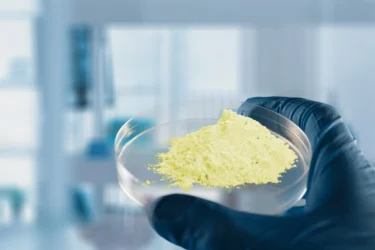
Though there are studies that show the benefits of the herb in various conditions, these are insufficient and there is a need for further studies to establish the true extent of the benefits of Gandhak Rasayan on human health.
Gandhak Rasayan is used in tablet form for the management and potential treatment of various diseases8. It may also be used in the form of topical agents like lotions mixed with other herbal medicines to treat skin disorders7. Gandhak Rasayan is also used as a powder with different herbal juices2.
You must consult a qualified doctor before taking any herbal supplements. Do not discontinue or replace an ongoing treatment of modern medicine with an ayurvedic/herbal preparation without consulting a qualified doctor.
The most common Gandhak Rasayan side effects are loose stools, upset stomach, abdominal cramps, and bloating2. The histopathological analysis of rat models administered with repeated doses of Gandhak Rasayan showed mild hemorrhage in the Kidneys of rats along with mild fatty liver1.
In my experience, Gandhak Rasayana may be used to delay the premature greying of hair. Gandhak Rasayana has a proven rejuvenator property10.
Dr. Rajeev Singh, BAMS
Since there is insufficient information available on the safety and efficacy of Gandhak Rasayan during pregnancy and breastfeeding, it is best to avoid this rasayan in these groups2.
Though there is no information on the interaction of gandhak rasayan with other drugs, some medications should never be combined. If you’re using any other prescription or nonprescription (over-the-counter [OTC]) medication, consult your doctor before taking it.
The side effects of Gandhak Rasayan include loose stool, abdominal cramps, upset stomach, and bloating. Fatty liver and kidney hemorrhage are also some other side effects reported in preclinical studies.
Gandhak Rasayan may help in relieving pain, managing diabetes, respiratory and skin disorders along treating allergies. It may also act as an appetizer and rejuvenator. Gandhak Rasayan may also help in building immunity and positive health.
It is mostly advised to avoid Gandhak Rasayan during pregnancy and lactation. One should always consult a medical health practitioner before taking any herbal drugs.
Gandhak Rasayan consists of sulfur, cow milk, cinnamon, amala, cardamom, patra, guduchi, vibhitaki, haritaki, shunto, and bringharaj along with sugar and water.
It is available as Gandhak Rasayan powder, which can be formulated as Gandhak Rasayan vati (tablet) and as a topical lotion for skin disorders.
Disclaimer: The information provided here is for educational/awareness purposes only and is not intended to be a substitute for medical treatment by a healthcare professional and should not be relied upon to diagnose or treat any medical condition. The reader should consult a registered medical practitioner to determine the appropriateness of the information and before consuming any medication. PharmEasy does not provide any guarantee or warranty (express or implied) regarding the accuracy, adequacy, completeness, legality, reliability or usefulness of the information; and disclaims any liability arising thereof.
Links and product recommendations in the information provided here are advertisements of third-party products available on the website. PharmEasy does not make any representation on the accuracy or suitability of such products/services. Advertisements do not influence the editorial decisions or content. The information in this blog is subject to change without notice. The authors and administrators reserve the right to modify, add, or remove content without notification. It is your responsibility to review this disclaimer regularly for any changes.
“As long as we are not living in harmony with nature, we cannot expect ourselves to heal.” Have you ever heard about the miracle tree? The drumstick tree or Moringa, is called the miracle tree as every part of it benefits humans and animals. Due to this reason, In Sanskrit, the drumstick tree is called Shobhanjana, meaning auspicious. Other names for the drumstick tree include the horseradish tree (English), Sainjna or Saguna (Hindi) and Akshiva or Haritashaaka (Ayurveda). The scientific name of drumstick tree is Moringa oleifera and it is a member of the Moringaceae family. It is a fast-growing evergreen tree cultivated worldwide from India to Africa and numerous other arid and other tropical countries. The leaves, flowers, seeds and roots of the drumstick trees are edible and are used to prepare a variety of delicious recipes. This “tree of life” has various benefits; let us know more about the uses and benefits of drumstick tree leaves1.
Friendly Reminder: The information shared here is for educational purposes only and the reader should consult a registered medical practitioner before implementing any changes to their health routine.
The leaves of the drumstick tree are packed with the goodness of carbohydrates, proteins, fats, carotenoids, vitamins A and E and minerals like potassium, calcium, iron, magnesium, etc. The phytochemicals in drumstick tree include flavonoids, phenolic compounds, glucosinolates and carotenoids. The nutritional value of the drumstick plant per 100 grams is given below:
Based on my observations, I have found that different parts of the drumstick tree, including the leaves, pods, and roots, may possess pain-reducing properties. I recommend considering the use of drumstick as a natural remedy for pain relief7.
Dr. Siddharth Gupta, B.A.M.S, M.D (Ayu)
Drumstick tree shows numerous scientifically proven properties; some of which are mentioned below1:
Be careful when consuming Moringa leaves! They contain a high concentration of saponins, which can interfere with the absorption of important minerals like zinc and magnesium. It is important to be mindful of this potential risk and monitor your Moringa leaves intake8.
Dr. Smita Barode, B.A.M.S, M.S.
Some of the potential benefits of the Drumstick tree are described below:

Cancers of the colon and rectum are the third most lethal cancers affecting both males and females equally. Asmari et al. conducted a review in 2015 stating that Drumstick tree halts the abnormal multiplication of colorectal cells and inhibits the formation and progression of cancer cells2. This effect is attributed due to the presence of eugenol, a polyphenol present in drumstick leaves. This indicates that the consumption of drumsticks may help manage colorectal cancers. Also, the presence of carotenoids and flavonoids may help in exerting a protective effect against cancers. However, to claim these results in humans, we need more studies. Additionally, it is advised to consult a physician for the proper management of colorectal cancer and not consider usage of drumstick trees as a remedy for cancers.

High blood pressure or hypertension is a condition in which blood flows through the arteries at very high pressure. Direk et al. conducted an animal study3 in 2019 stating drumstick consumption helps in relaxing the arteries and thus helps reduce blood pressure. This states that drumsticks may have the potential to manage hypertension. However, we need more human trials to claim these effects with greater reliability. It is better to take a professional opinion if you suffer from high blood pressure instead of self-medicating.
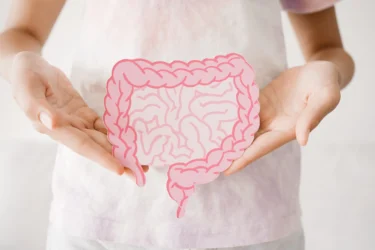
Colitis is a condition characterised by inflammation and ulceration in the digestive tract. A review4 by Mohsen et al. done in 2014 states that drumsticks may have the potential to manage colitis by reducing inflammation and ulcers. This effect is attributed to the presence of polyphenols which exert anti-inflammatory and antioxidant properties. Thus, it may be concluded that drumsticks may have the potential to manage colitis. However, we need more human studies to claim these results with greater reliability. Additionally, it is always advised to consult a physician for the proper management of colitis and not rely on self-medication with the drumstick tree.

Medicinal plants like the drumstick tree are coming into the limelight as antibacterial agents. Abalaka et al. conducted a study5 in 2012 to test the efficacy of the drumstick trees on different bacteria like E.coli, H.pylori, S.typhi, K.pneumonia, etc. A plant-based chemical called glucosinolate present in the leaves of this tree inhibits the growth of these bacteria; thus drumstick leaves may have the potential to manage bacterial infections caused by the above-mentioned bacteria and help in managing infections like urinary tract infections, typhoid, pneumonia, etc. However, we need more studies to confirm these results in humans. It is recommended to avoid self-medication and consult your physician for the proper management of any bacterial infection.

Diabetes (Type I & II) is a metabolic disorder characterised by an increase in blood glucose due to decreased production or resistance of a hormone called insulin which regulates blood glucose. A review1 conducted by Piyush et al. in 2022 stated that the drumstick tree might have the potential to decrease blood glucose levels. This effect is attributed to polyphenols that inhibit enzymes that break down carbohydrates into simpler sugars and increase blood glucose. Additionally, the antioxidant effect plays an important role in reducing the increased blood glucose. Therefore, the leaves of drumstick tree may have the potential to manage diabetes. However, it is advised not to generalise these results in the management of diabetes. To claim these results and apply them in humans, we need more studies. In addition, you should consult your physician for the proper management of diabetes and not rely on self-medication.
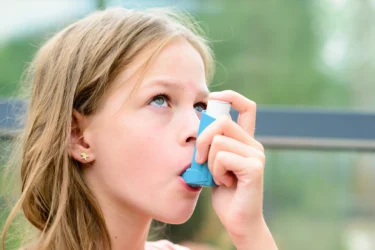
Though there are studies that show the benefits of Drumstick tree in various conditions, these are insufficient and there is a need for further studies to establish the true extent of the benefits of drumstick tree on human health.
I highly recommend incorporating drumstick tree extracts into your diet, as it might be an exceptional source of vitamin A. This essential nutrient has the potential to safeguard your eye health and stave off deficiencies. Including drumsticks in your meals, especially for your children, is a great step towards maintaining optimal vision and promoting eye health7.
Dr. Rajeev Singh, BAMS
You must consult a qualified doctor before taking any herbal supplements. Do not discontinue or replace an ongoing treatment of modern medicine with an ayurvedic/herbal preparation without consulting a qualified doctor.
A review1 by George et al. in 2016 stated that drumstick contains high metallic content which can be toxic to humans. Therefore, excessive consumption of drumsticks should be avoided.
However, if you experience any adverse reactions to the drumstick tree, it is advised to discontinue its intake and immediately contact a doctor or your Ayurvedic physician who has prescribed it. They will be able to guide you appropriately for your symptoms.
Consuming Drumstick tree is okay if taken in moderate amounts. However, general precautions must be followed in the following conditions1:
However, you must always seek the advice of your Ayurvedic physician about the possible interaction of Drumstick tree with other drugs and follow the prescription thoroughly, as they will know your health condition and other medications you are taking.
The scientific name of the drumstick tree is Moringa oleifera and it is a member of the Moringaceae family1.
The drumstick tree is called the miracle tree1.
In Hindi, the drumstick tree is called as Sainjna or Saguna.
Yes, intake of the leaves of the Drumstick tree may help in weight loss.
There is no study stating benefits of drumstick leaves to manage jaundice.
Disclaimer: The information provided here is for educational/awareness purposes only and is not intended to be a substitute for medical treatment by a healthcare professional and should not be relied upon to diagnose or treat any medical condition. The reader should consult a registered medical practitioner to determine the appropriateness of the information and before consuming any medication. PharmEasy does not provide any guarantee or warranty (express or implied) regarding the accuracy, adequacy, completeness, legality, reliability or usefulness of the information; and disclaims any liability arising thereof.
Links and product recommendations in the information provided here are advertisements of third-party products available on the website. PharmEasy does not make any representation on the accuracy or suitability of such products/services. Advertisements do not influence the editorial decisions or content. The information in this blog is subject to change without notice. The authors and administrators reserve the right to modify, add, or remove content without notification. It is your responsibility to review this disclaimer regularly for any changes.
“Ayurveda, a most sacred science of life, is beneficial to humans both in this world and the world beyond”. Ayurveda focuses on improving human health and well-being through herbs and spices. One such herb which is of great significance is Madhunashini. Madhunashini is also known as meshashringi (Sanskrit), gurmar and merasingi (Hindi), vakundi, kavuli and kalikardori (Marathi), dhuleti and mardashingi (Gujarathi), Podapatri (Telugu) and Cherukurinja (Tamil). The scientific or botanical name of Madhunashini is Gymnema sylvestre and it belongs to the Asclepiadaceae family. It is a medicinal woody climber native to western and Central India, Australia, and tropical Africa. In India, it is widely grown in Bihar, Chhattisgarh Andhra Pradesh, Kerala, Karnataka, Uttar Pradesh, Madhya Pradesh, and West Bengal. The leaves, flowers, and root extracts have medicinal properties. Let us know more about the health benefits of this wonder plant1,2.
Madhunashini has nutrients like carbohydrates, proteins, and other phytochemical constituents like saponins, sterols, terpenoids, glycosides, alkaloids, resins, etc3.
Did you know?
Scientifically proven properties of Madhunashini include1:
Based on my experience, I have found that the leaf extract of madhunashini might have antiarthritic effects. The extract contains certain compounds that could potentially inhibit inflammation and reduce the release of pain-causing substances, which may help in managing arthritic symptoms8.
Dr. Siddharth Gupta, B.A.M.S, M.D (Ayu)
Some of the potential benefits of Madhunashini are described as under:

We can’t deny that diabetes is one of the most common diseases, showing an increasing trend worldwide. Even in their 20s, youngsters have complaints of high blood glucose levels because of unhealthy dietary choices and a sedentary lifestyle. A review1 by Kanetkar et al. in 2007 stated that Madhunashini exerts anti-diabetic effects due to the presence of gymnemic acids. The possible mechanism attributed is an increase in insulin secretion, a hormone that regulates blood glucose. Additionally, gymnemic acids help inhibit glucose absorption from the intestine and increase glucose utilization. This indicates that Madhunashini may help manage diabetes. However, more studies are needed to support these claims with greater reliability1.

A lipid profile is a blood test that measures the number of triglycerides and cholesterol in the blood. An altered lipid profile is a risk factor for diseases like atherosclerosis, pancreatitis, etc. Eisenberg et al. 2003 conducted a study8 in rats. This study showed that Madhunashini leaf extracts could reduce serum triglycerides, low-density lipoprotein, total cholesterol, etc. This indicates that Madhunashini has the potential to correct an abnormal lipid profile. However, these results are based on animal studies and more studies are needed to claim these effects in humans4.

Obesity is a complex disease characterized by excess body fat, which can negatively affect health. Studies have supported the fact that using food sources in the right quantity and the use of complementary and alternative medicine like yoga and ayurvedic herbs may help in weight loss. A review4 conducted by Fabio et al. in 2013 stated that Madhunashini has the potential to manage obesity. This effect is attributed to inhibiting taste perception by gymnemic acids present in Madhunashini leaf and root extracts which may limit your food intake. This indicates that the Madhunashini may aid weight loss by decreasing the intake of calories. However, we need more studies to support these claims with greater reliability4,5.

Cancer is a disease in which cells of the body may multiply abnormally and form cancerous cells that may spread to other parts of the body. A review4 conducted by Fabio et al. in 2013 states that Madhunashini may help manage breast and lung cancer. The exact mechanism behind this effect is, however, still being determined. This indicates that Madhunashini may help with cancer. However, scientific evidence supporting these claims is limited. Therefore, we need more studies to support these claims4.

Many antibacterial agents in Ayurveda have been used for managing bacterial infections; one such agent is Madhunashini. A review4 conducted by Fabio et al. in 2013 stated that Madhunashini leaf extract might have antibacterial activity against bacteria like E.coli and Salmonella species. By killing these bacteria, Madhunashini may help manage urinary tract infections, diarrhoea, typhoid, etc. This indicates that it may help manage a wide range of bacterial infections. Additionally, it may also help in managing dental caries, usually caused by bacteria, and thus may help improve dental hygiene. However, there is no scientific study done on humans to support these claims4.
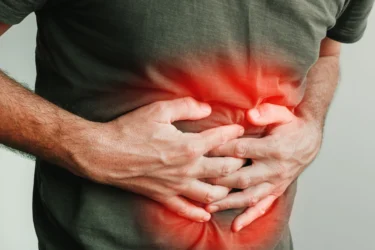
Though there are studies that show the benefits of Madhunashini in various conditions, these are insufficient, and there is a need for further studies to establish the true extent of the benefits of Madhunashini on human health.
In my experience, madhunashini extract may have potential benefits in wound healing. The extract contains flavonoids, which are known for their antioxidant properties. While further studies are needed, incorporating its extract in wound care may support the healing process8.
Dr. Rajeev Singh, BAMS
You must consult a qualified doctor before taking any herbal supplements. Do not discontinue or replace an ongoing treatment of modern medicine with an ayurvedic/herbal preparation without consulting a qualified doctor.
Did you know that the root bark of Madhunashini has been historically used as an emetic, expectorant, and analgesic for body aches? It has also been utilized as a traditional remedy for snakebites, with the root juice playing a role in its treatment8.
Dr. Smita Barode, B.A.M.S, M.S.
However, if you experience any adverse reactions to Madhunashini, it is advised to discontinue its intake and immediately contact a doctor or your Ayurvedic physician who has prescribed it. They will be able to guide you appropriately for your symptoms.
Also Read: Gokshuradi Guggulu: Uses, Benefits, Side Effects and more!
Consuming Madhunashini is okay if taken in moderate amounts. However, general precautions must be followed in the following conditions7:
Also Read: Vasaka (Malabar Nut): Uses, Benefits and Side Effects by Dr. Rajeev Singh
However, you must always seek the advice of your Ayurvedic physician about the possible interaction of Madhunashini with other drugs and follow the prescription thoroughly, as they will know your health condition and other medications you are taking7.
Also Read: Triphala: Uses, Benefits, Side Effects & More!
Madhunashini is also known as meshashringi (Sanskrit), gurmar and merasingi (Hindi), vakundi, kavuli and kalikardori (Marathi), dhuleti and mardashingi (Gujarathi), Podapatri (Telugu) and Cherukurinja (Tamil)1.
The scientific name of the Madhunashini plant is Gymnema sylvestre, which belongs to the Asclepiadaceae family1.
No, there are no interactions of Madhunashini with food7.
Yes, it is available in the market as Madhunashini tablet, capsules, extract, powder, paste, etc6.
Madhunashini in Tamil is known as Cherukurinja1.
Disclaimer: The information provided here is for educational/awareness purposes only and is not intended to be a substitute for medical treatment by a healthcare professional and should not be relied upon to diagnose or treat any medical condition. The reader should consult a registered medical practitioner to determine the appropriateness of the information and before consuming any medication. PharmEasy does not provide any guarantee or warranty (express or implied) regarding the accuracy, adequacy, completeness, legality, reliability or usefulness of the information; and disclaims any liability arising thereof.
Links and product recommendations in the information provided here are advertisements of third-party products available on the website. PharmEasy does not make any representation on the accuracy or suitability of such products/services. Advertisements do not influence the editorial decisions or content. The information in this blog is subject to change without notice. The authors and administrators reserve the right to modify, add, or remove content without notification. It is your responsibility to review this disclaimer regularly for any changes.
You’ve probably heard of this disclaimer on multiple occasions – ‘smoking is injurious to health’. What you may not immediately realise is the extent of the damage smoking can cause to your health and, most directly, your lungs.
Smoking is known to be the leading cause of preventable diseases and deaths globally. Nearly all forms of lung cancer, the top cause of cancer death in both men and women, can be attributed to smoking. Tobacco and tobacco-related products can damage the lungs’ ability to supply oxygen to the body. Other substances commonly found in cigarette smoke can cause permanent lung damage, even in small amounts.
A single puff of cigarette smoke contains upwards of 7,000 chemicals. Tobacco smoke contains over 70 known cancer-causing chemicals2. When you breathe these in, these toxins go deep into your lungs and can cause swelling, resulting in a host of other respiratory diseases.
Both tobacco and chemical substances found in cigarettes can change the cellular structure of the lungs. They can cause the elastic walls within the airways to break down – resulting in less functioning surface area in the lungs. Cigarettes can damage lung tissue, preventing them from functioning correctly. This can increase the risk of diseases caused by smoking, such as chronic bronchitis, emphysema, respiratory diseases, asthma and COPD (Chronic Obstructive Pulmonary Disease)1.
Nicotine in tobacco can also damage the ability of the respiratory system to filter out dust and dirt. This can lead to toxic substances passing through, resulting in lung congestion and the ‘smoker’s cough’.
A person who smokes throughout life is at high risk of developing a range of potentially fatal diseases owing to impaired lung function and breathlessness due to swelling and narrowing of the lung airways and excess mucus build-up. They are also prone to weakening the lungs’ clearance system, leading to the accumulation of toxic substances and causing lung irritation and damage. Further, they are also at an increased risk of lung infection, chronic bronchitis and heightened risk of asthma, along with permanent damage to air sacs3.
In the longer term, smoking is known to induce heart disease and stroke, in certain cases, it can cause ulcers of the digestive system and put smokers at increased risk of type 2 diabetes.
Most smokers are also likely to develop emphysema. The number of cigarettes you smoke and other lifestyle factors may impact the extent of the damage. If you’re diagnosed with either of these respiratory diseases – emphysema or chronic bronchitis, you run the risk of being diagnosed with chronic obstructive pulmonary disease (COPD).
Smoking can affect a person’s health in other ways, too, harming almost every organ in the body. In most cases, it can result in a compromised immune system function, making you susceptible to many other illnesses. It can also lead to lower bone density (brittle bones), which increases the risk of broken bones and fractures. Smoking also leaves you at a higher risk of rheumatoid arthritis, heart disease and stroke, along with an increased risk for cataracts (clouding of the eye lenses).
Apart from respiratory diseases, other visible disorders include an increased risk of oral cancers, gum disease and tooth loss, premature ageing of the skin, bad breath and stained teeth and an increased risk for age-related macular degeneration, which can lead to blindness. Moreover, even your wounds may take longer to heal!
Also Read: 6 Simple Exercises to Improve Your Lung Health
It’s never too late to quit smoking. Within days of quitting smoking, lungs begin to repair themselves. In fact, just 12 hours after you quit, the amount of carbon monoxide in your blood drops to a much healthier level. More oxygen flows to your vital organs and you will be able to breathe better. In about 10 to 15 years, your risk of developing lung cancer reduces and may even become the same as a non-smoker4.
1. Centers for Disease Control and Prevention (US); National Center for Chronic Disease Prevention and Health Promotion (US); Office on Smoking and Health (US). How Tobacco Smoke Causes Disease: The Biology and Behavioral Basis for Smoking-Attributable Disease: A Report of the Surgeon General. Atlanta (GA): Centers for Disease Control and Prevention (US); 2010. 7, Pulmonary Diseases. Available from: https://www.ncbi.nlm.nih.gov/books/NBK53021/
2. National Cancer Institute. Harms of Cigarette Smoking and Health Benefits of Quitting [Internet]. Bethesda (MD): National Cancer Institute; reviewed 19 December 2017 [cited 2025 Sep 19]. Available from: https://www.cancer.gov/about-cancer/causes-prevention/risk/tobacco/cessation-fact-sheet
3. Varghese J, Muntode Gharde P. A Comprehensive Review on the Impacts of Smoking on the Health of an Individual. Cureus. 2023 Oct 5;15(10):e46532. doi: 10.7759/cureus.46532. PMID: 37927763; PMCID: PMC10625450. Available from: https://pmc.ncbi.nlm.nih.gov/articles/PMC10625450/
4. Centers for Disease Control and Prevention. Benefits of Quitting Smoking [Internet]. Atlanta (GA): CDC; updated May 15, 2024 [cited 2025 Sep 19]. Available from: https://www.cdc.gov/tobacco/about/benefits-of-quitting.html
Disclaimer: The information provided here is for educational/awareness purposes only and is not intended to be a substitute for medical treatment by a healthcare professional and should not be relied upon to diagnose or treat any medical condition. The reader should consult a registered medical practitioner to determine the appropriateness of the information and before consuming any medication. PharmEasy does not provide any guarantee or warranty (express or implied) regarding the accuracy, adequacy, completeness, legality, reliability or usefulness of the information; and disclaims any liability arising thereof.
Links and product recommendations in the information provided here are advertisements of third-party products available on the website. PharmEasy does not make any representation on the accuracy or suitability of such products/services. Advertisements do not influence the editorial decisions or content. The information in this blog is subject to change without notice. The authors and administrators reserve the right to modify, add, or remove content without notification. It is your responsibility to review this disclaimer regularly for any changes.
The gall bladder is an organ on the right side of the abdomen and is located below the liver. It stores the digestive juice (bile) secreted by your liver, which is then released into the small intestine to help break down fats. Cholelithiasis is the medical term for gallstones, which are solid deposits formed in the gall bladder. These occur in a range of sizes and can be single or multiple in number.
The symptoms of gall bladder stones may include abdominal pain, indigestion, back pain, fever, and vomiting1. In case you experience any of these symptoms for over a few hours or repeatedly, consult your doctor for diagnosis and treatment.
Remember, diet can play an important role in managing the symptoms of many conditions, including gall bladder stones. So, what should you eat and what foods should you avoid when you have gall bladder stones?
As a doctor, I advise individuals with gallstones to incorporate foods rich in vitamin B and iron into their diet. Some examples may include whole grains, dark leafy greens like spinach and kale, and sea vegetables. These nutrient-rich foods may provide essential vitamin B and iron, which are important for maintaining overall health.
Dr. Anuja Bodhare, B.A.M.S, M.D (Ayu)
A healthy diet may not help to fight all the symptoms of gall bladder stones or save you from surgery; however, it may help avoid worsening of the symptoms. This article aims to provide a guideline on what foods you should include in your diet to help reduce the stress on your gall bladder. We recommend consulting a doctor and a nutritionist for an appropriate meal plan.
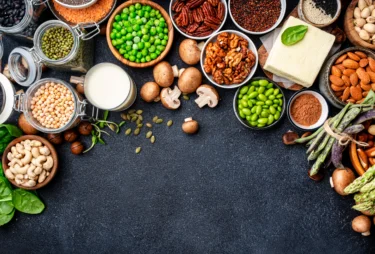
It is common knowledge that plant-based foods such as fruits and vegetables are rich in nutrients, which are essential for the body to stay healthy and functional. They also provide an ample amount of vitamins, minerals, and antioxidants. These antioxidants help remove toxins and free radicals produced by natural processes and processed food. A build-up of toxins can break down the body’s natural balance and cause cell damage. Plant-based foods offer the nutrition needed to get better and help reduce the stress on the digestive system2. Another advantage is that plant-based foods decrease the risk of cholesterol, which may help manage gallbladder stones associated with cholesterol.
As a piece of advice that I consistently offer to patients with gallstones, I recommend basing their meals on starchy carbohydrates such as bread, pasta, rice, and potatoes. By focusing on these wholesome carbohydrates, individuals with gallstones may create a nourishing and gallstone-friendly diet that promotes good health that contributes to a better you9!
Dr. Smita Barode, B.A.M.S, M.S.

Including a source of protein that is low in saturated fat might help lower the levels of bad cholesterol in our bodies. Red meat, a good source of protein, is high in fat, which can put stress on the gall bladder. Thus, choosing lean protein sources might help you manage the symptoms of gall bladder stones. Some common options are:
You should avoid dairy products and also processed meats as they generally have higher salt content. According to a study published in the database of the National Institutes of Health, a higher intake of vegetable protein might help lower the risk of gall bladder conditions3.
Based on my personal experience, I have found a great way to add more fruits to a gallstone-friendly diet. I recommend including fruits like bananas, berries, or a handful of dried fruit in your breakfast cereal. By doing so, you may enjoy a delicious and nutritious start to your day while ensuring you incorporate the benefits of fruits into your diet.
Dr. Rajeev Singh, BAMS
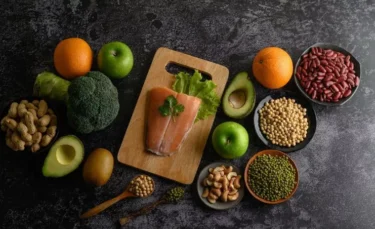
Fibre is essential for good digestive health and enhances the movement of food through our gut. Thus, fibre-rich foods help lower the production of secondary bile acids, which can help decrease the stress on the gall bladder. According to a study published in the National Library of Medicine, a high-fibre diet helped decrease the production of biliary sludge (thick bile that can form gallstones)4. An increase in the amount of this sludge means an increase in the risk of gall bladder diseases. Thus, people who follow a fibre-rich diet might be at a reduced risk of gallbladder stones. It also suggests that a fibre-rich diet might offer relief to people affected with gall bladder stones. Some sources of fibre are:-
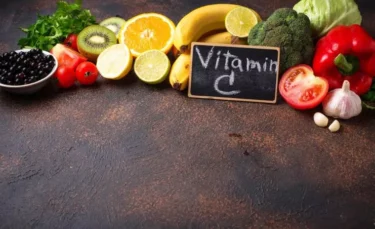
According to a hospital case study published by the National Library of Medicine, vitamin C, magnesium, and folate can help reduce the risk of gall bladder diseases and improve your gall bladder health5. Some sources high in vitamin C are:-
As part of a gallstone-friendly diet, I may suggest incorporating healthy fats such as fish oil. It may help support the regular contraction and emptying of the gallbladder8.
Dr. Siddharth Gupta, B.A.M.S, M.D (Ayu)
Now that we know about what foods we should include in our diet for a healthy gall bladder, let us look at foods we should avoid.
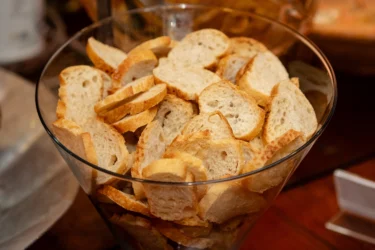
Unrefined carbohydrates are considered to be healthy and some sources, like whole grains and cereals, can provide essential nutrients. However, refined carbohydrates are more difficult to digest and may increase the risk of gall bladder diseases6. Some carbohydrates that you need to steer clear of are:-
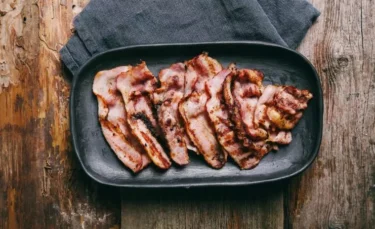
The bile produced in the gall bladder helps dissolve fats. However, it is difficult to break down saturated and trans fats, which may add to the stress on the gall bladder2. Some major sources of unhealthy fats are:-

Despite taking precautions, in some cases, the gallbladder may still need to be removed. Removal of the gall bladder does not have any serious adverse effects on the body’s digestive system. However, other body systems will take time to adjust, during which the individual must make certain dietary changes to accommodate the body’s condition. Some common tips include:-
Always be sure to consult your doctor if you have nausea and pain.
The management of gall bladder stones primarily depends on adopting a balanced, plant-based diet with lean proteins, fibre-rich foods, and adequate vitamin C. Removing refined carbohydrates and unhealthy fats from your diet may help you avoid further stone formation. After gall bladder removal, eating smaller, lighter meals and allowing your digestive system time to adjust may help support faster recovery and long-term digestive health.
It is important to adopt a diet that puts less stress on the digestive system and is rich in fibre to help promote digestion. Refer to the article for detailed guidelines.
Avoid oily and deep-fried foods. Anything that triggers indigestion or bloating must be avoided.
Some common drinks that you can safely consume while you have gallstones are apple cider vinegar, apple juice, peppermint tea, turmeric tea, buttermilk and water. You should avoid drinks like caffeine that can further upset your digestive system.
The best way to get rid of pain due to gallbladder stones is by the surgical removal of the gallbladder. Other ways can be the medicines advised by your doctor.
Disclaimer: The information provided here is for educational/awareness purposes only and is not intended to be a substitute for medical treatment by a healthcare professional and should not be relied upon to diagnose or treat any medical condition. The reader should consult a registered medical practitioner to determine the appropriateness of the information and before consuming any medication. PharmEasy does not provide any guarantee or warranty (express or implied) regarding the accuracy, adequacy, completeness, legality, reliability or usefulness of the information; and disclaims any liability arising thereof.
Links and product recommendations in the information provided here are advertisements of third-party products available on the website. PharmEasy does not make any representation on the accuracy or suitability of such products/services. Advertisements do not influence the editorial decisions or content. The information in this blog is subject to change without notice. The authors and administrators reserve the right to modify, add, or remove content without notification. It is your responsibility to review this disclaimer regularly for any changes.
Next Page »« Previous Page